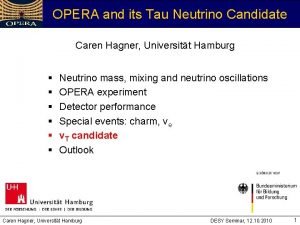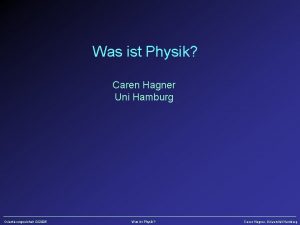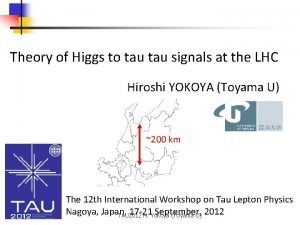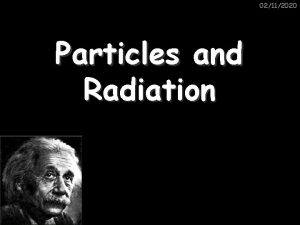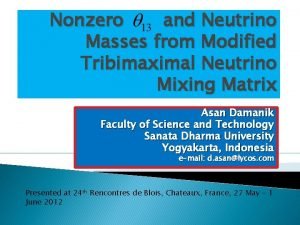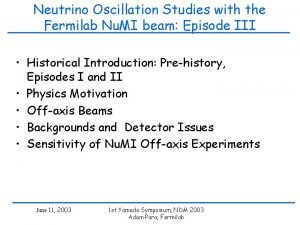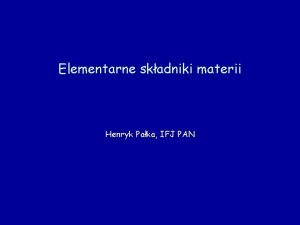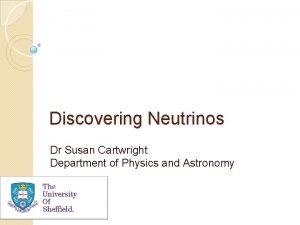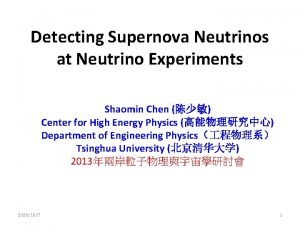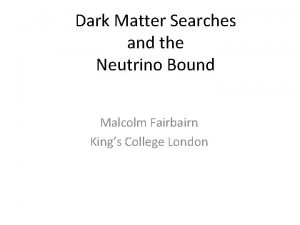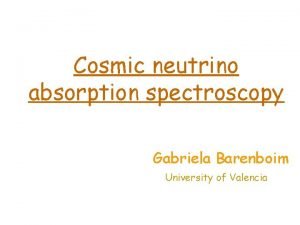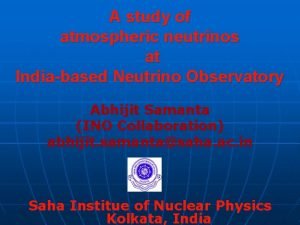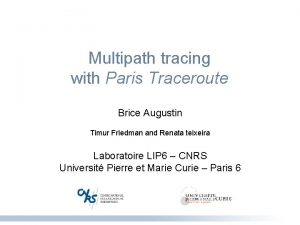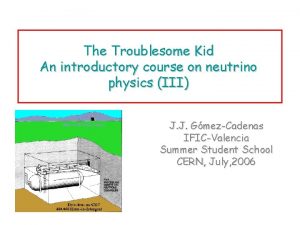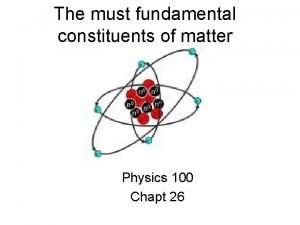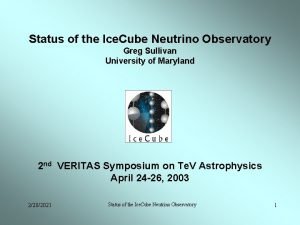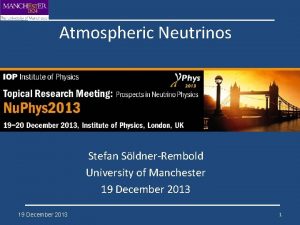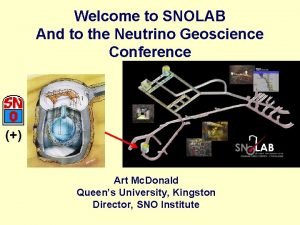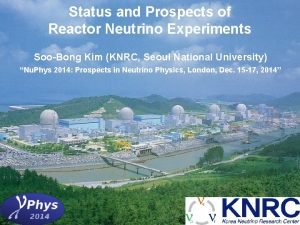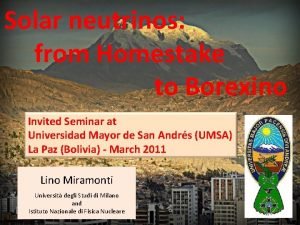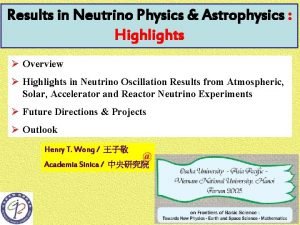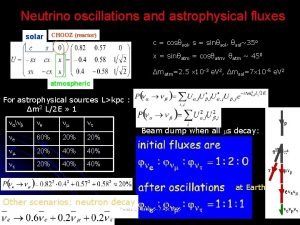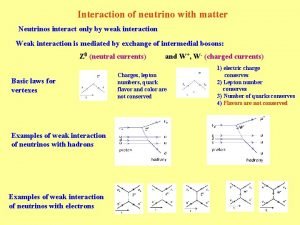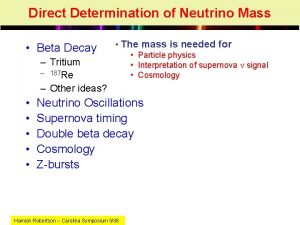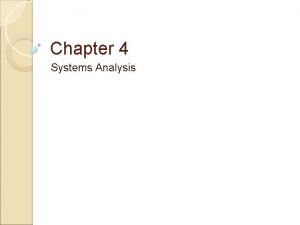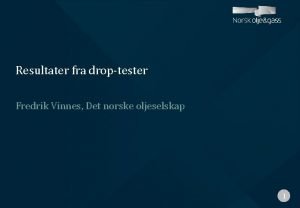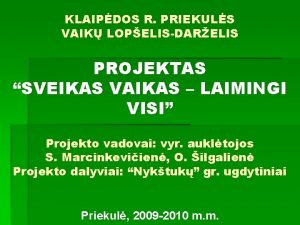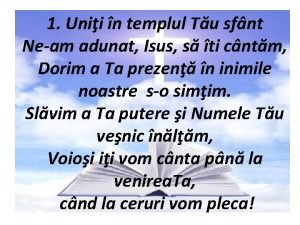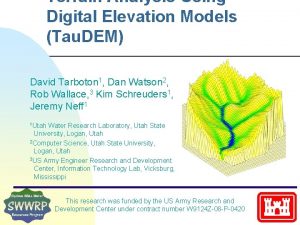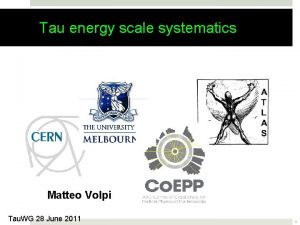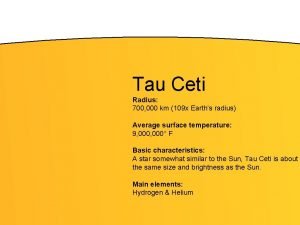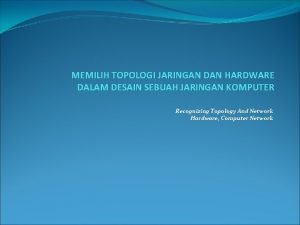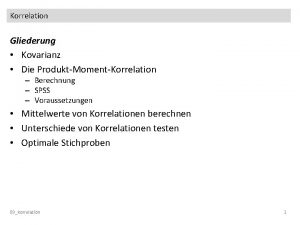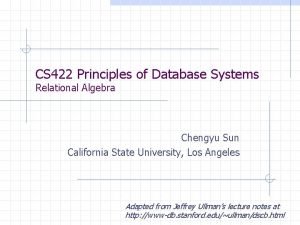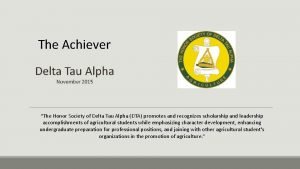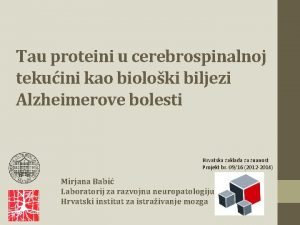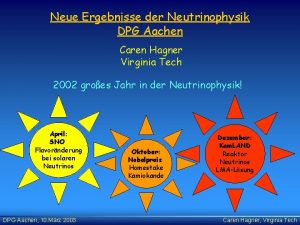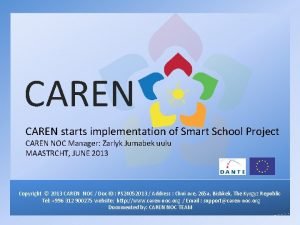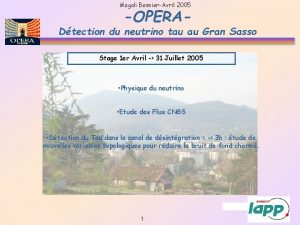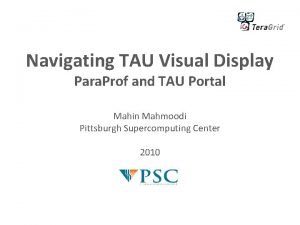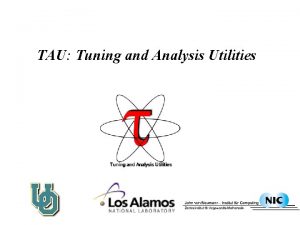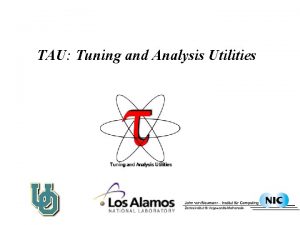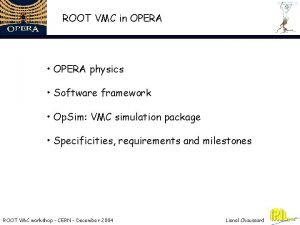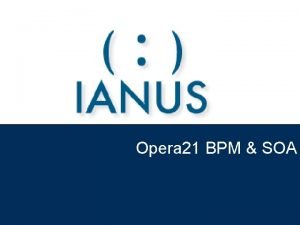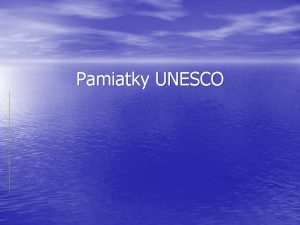OPERA and its Tau Neutrino Candidate Caren Hagner
















































- Slides: 48

OPERA and its Tau Neutrino Candidate Caren Hagner, Universität Hamburg § § § Neutrino mass, mixing and neutrino oscillations OPERA experiment Detector performance Special events: charm, ve v. T candidate Outlook Caren Hagner, Universität Hamburg DESY Seminar, 12. 10. 2010 1

Neutrino Mass and Mixing Δm 2 solar = m 22 - m 12 ≈ 8· 10 -5 e. V 2, |Δm 2 atm | = |m 32 - m 22| ≈ 2· 10 -3 e. V 2 θatm θ 23 ≈ 45 o Caren Hagner, Universität Hamburg θ 13, δ θ 13<13 o, δ ? θsol θ 12 ≈ 33 o DESY Seminar, 12. 10. 2010 2

Neutrino Oscillations (simplified) Flavor eigenstates vμ, vτ Mass eigenstates v 2, v 3 with θ 23 ≈ 45 o source creates flavor-eigenstates vμ propagation determined by mass-eigenstates v 2 detector sees flavor-eigenstates vτ v 3 τ W W μ slightly different frequencies → phase difference changes Caren Hagner, Universität Hamburg p, n hadrons DESY Seminar, 12. 10. 2010 3

MINOS Results: Fit to Oscillation Hypothesis (best fit) (for 7. 2· 1020 pot) Caren Hagner, Universität Hamburg DESY Seminar, 12. 10. 2010 4

OPERA: Oscillation Project with Emulsion t. Racking Apparatus Neutrino beam (vμ) from CERN to Gran Sasso Underground Lab (Italy) Goal: Observation of vτ Appearance 732 km LNGS Physics runs: 2008 and 2009 completed, 2010 ongoing Caren Hagner, Universität Hamburg DESY Seminar, 12. 10. 2010 5

CNGS beam (“pure” vμ) comparison of CC-event rates: Prompt vτ negligible ( ≈ 10 -7) 400 Ge. V p on graphite target Total exposure expected: 22. 5· 1019 pot Caren Hagner, Universität Hamburg 4. 5· 1019 pot/year DESY Seminar, 12. 10. 2010 6

Profile of neutrino beam @ LNGS CNGS beam at 732 km (FLUKA 2005) Caren Hagner, Universität Hamburg DESY Seminar, 12. 10. 2010 7

OPERA: vτ detection vτ τ- τ-decay: kink W trident p, n hadrons Typical topology of τ-decay: “Kink” within 1 mm from vertex 1 mm - μ- nτ Hadrons Lead Emulsions Caren Hagner, Universität Hamburg DESY Seminar, 12. 10. 2010 8

Background Processes Most important background processes: • Charm production and decay • Hadron re-interactions in lead • Large angle myon scattering in lead Background Signal CC , e, hadron Caren Hagner, Universität Hamburg CC + charm prod. charm muon misidentified DESY Seminar, 12. 10. 2010 9

Expected Signal Assume: Maximal mixing, 22. 5 x 1019 pot (=5 years @ 4. 5 x 1019 pot/year) decay channel B. R. (%) Signal m 2 = 2. 5 x 10 -3 e. V 2 Background 17. 7 2. 9 0. 17 e 17. 8 3. 5 0. 17 h 49. 5 3. 1 0. 24 3 h 15. 0 0. 9 0. 17 10. 4 0. 75 Total Expected events: ~ 23600 vμ CC+NC interactions ~ 160 ve interactions ~ 115 vτ CC interactions ~ 10 identified vτ < 1 background Caren Hagner, Universität Hamburg DESY Seminar, 12. 10. 2010 10

OPERA target: lead-emulsion-bricks 57 emulsion / 56 lead 10 X 0 100 mm 8 kg lead-emulsion-brick (total ≈ 150. 000) target mass: ≈ 1, 35 kton 105000 m 2 of lead surface 111000 m 2 of film surface (9 million films) „Emulsion Cloud Chamber“ (ECC) Caren Hagner, Universität Hamburg DESY Seminar, 12. 10. 2010 11

Hybrid Target Structure CS doublet alignment by Compton electrons: 2. 5 microns Caren Hagner, Universität Hamburg DESY Seminar, 12. 10. 2010 12

OPERA - Detector Supermodule 1 Caren Hagner, Universität Hamburg Supermodule 2 DESY Seminar, 12. 10. 2010 13

OPERA - Detector Target SM 1 Target SM 2 Target Region: - Target Tracker (Scintillator) - Lead/Emulsion Bricks (75. 000 per Supermodule) Caren Hagner, Universität Hamburg DESY Seminar, 12. 10. 2010 14

OPERA - Detector Target μ v X B B Magnetic Spectrometer: Magnet-Region: Precision Tracker: Iron & RPCs 6 Planes of Drifttubes Caren Hagner, Universität Hamburg DESY Seminar, 12. 10. 2010 15

The Electronic Detectors Target Trackers (Plastic Scintillator) 1. 52 T

Magnetic Spectrometer muon momentum Data (black hist. ) vs MC 10000 drift tubes (length 8 m) – built at DESY spatial resolution ≈ 250 m RPCs Caren Hagner, Universität Hamburg DESY Seminar, 12. 10. 2010 cm 17 17

Reconstruction (I): Magnetic Spectrometer Caren Hagner, Universität Hamburg DESY Seminar, 12. 10. 2010 18

Rekonstruktion (II): Brick Finding Caren Hagner, Universität Hamburg DESY Seminar, 12. 10. 2010 19

Brick Validation with Changeable Sheet Develop this brick Scanning effort/event: CHORUS 1 x 1 mm 2 DONUT 5 x 5 mm 2 OPERA 100 x 100 mm 2 So far, 640. 000 cm 2 of CS surface have been scanned in OPERA Caren Hagner, Universität Hamburg DESY Seminar, 12. 10. 2010 20

OPERA – Brick Manipulation System • automatic extraction of 25 bricks / 8 hour shift • ~90’ 000 bricks handled until 2009 for the extraction of ~7000 event bricks Caren Hagner, Universität Hamburg DESY Seminar, 12. 10. 2010 21

Handling the ECC bricks § Inserting and extracting the bricks by Brick Manipulation System (BMS) § Aligning the films (X-ray and cosmics) § Developing the films § Scanning Caren Hagner, Universität Hamburg DESY Seminar, 12. 10. 2010 22

Brick Analysis To Dubna Bern Padova Bologna apan J o T To Ankara Roma LNGS LNF Napoli Salerno Bari The selected bricks are sent to scanning labs (at present 12) Caren Hagner, Universität Hamburg DESY Seminar, 12. 10. 2010 23

Performance of Emulsion Film Detector Emulsion Layer (44 microns) Plastic Base (205 microns) basic detector: Ag. Br crystal, size = 0. 2 micron detection eff. = 0. 16/crystal 1013 “detectors” per film Emulsion Layer intrinsic resolution: 50 nm sensitivity 15 grains/44 microns mip electron ~ 100 ke. V 20 μm deviation from linear-fit line. (2 D) Caren Hagner, Universität Hamburg A. Ereditato - CERN - 4 June 2010 DESY Seminar, 12. 10. 2010 24 24

Scanning of Emulsions Japanese Scanning System (S-UTS) European Scanning System (ESS) 4 systems + sub systems 33 systems in Europe Total scanning power : 325 cm 2/h Total scanning power : 660 cm 2/h Caren Hagner, Universität Hamburg DESY Seminar, 12. 10. 2010 25

Scanning Field of view: 300 m Vertex reconstruction & kinematic analysis 2 d image: 16 tomographic images 44 m emulsion sheet

CNGS beam performance & statistics 2006 0. 076 x 1019 pot no bricks Commissioning 2007 0. 082 x 1019 pot 38 events Commissioning 2008 1. 78 x 1019 pot 1698 evts(scan input) First physics run 2009 3. 52 x 1019 pot 3693 evts(scan input) Physics run 2010 (ongoing) 3. 01 x 1019 pot (20. Sept. ) 3167 evts (20. Sept. ) Physics run pot 8· 1019 2010 8558 evts (scan input) collected until 20/9/2010 2009 2008 Caren Hagner, Universität Hamburg Days DESY Seminar, 12. 10. 2010 27 27

Example of a CC event: ‚kink‘-topology Caren Hagner, Universität Hamburg DESY Seminar, 12. 10. 2010 28

Example of a NC event: ‚kink‘-topology The measured ratio NC/CC is ≈20%, as expected from simulations Caren Hagner, Universität Hamburg DESY Seminar, 12. 10. 2010 29

Event statistics (June 2010) This analysis corresponds to ~35% of the 2008 -2009 run statistics, = 1. 89 x 1019 pot 1813 events found in the target (scan input) Events with neutrino vertices located by scanning: 1617 (Brick tagging efficiency) x (vertex location efficiency) ≈ 60% Events for which “decay search” was completed: 1088 (187 NC, 901 CC) With the above statistics, and for Dm 223 = 2. 5 x 10 -3 e. V 2 and full mixing, OPERA expects: ~ 0. 5 v events Caren Hagner, Universität Hamburg A. Ereditato - CERN - 4 June 2010 DESY Seminar, 12. 10. 2010 30 30

Impact Parameter Measurement IP distribution for: n events (MC) IP distribution for n events (MC) Mean IP = 104. 3 µm Impact Parameter (µm) Caren Hagner, Universität Hamburg NC+CC n events (MC), NC+CC n events (Data) expanded scale Impact Parameter (µm) DESY Seminar, 12. 10. 2010 31

Momentum Measurement with ECC and Electronic Detector Prec (Ge. V) Momentum measured in ECC (by multiple Coulomb scattering) ECC p test beam error bar: 68% CL Pbeam(Ge. V) Dp/p s = (22± 4)% Caren Hagner, Universität Hamburg Electronic Detector DESY Seminar, 12. 10. 2010 32

γ – Detection and Reconstruction of π0 mass EM shower energy measured by shower shape analysis and Multiple Scattering method E = 8. 1 Ge. V E = 0. 5 Ge. V 2 EM showers give a mass reconstructed mass ~ 160~Me. V reconstructed from 2 EM showers 160 Me. V Caren Hagner, Universität Hamburg DESY Seminar, 12. 10. 2010 33

p 0 mass resolution (real data) 35 gamma pairs 1 s mass resolution: ~ 66 Me. V Caren Hagner, Universität Hamburg DESY Seminar, 12. 10. 2010 34

Charm candidate event (dimuon) x-view 1 ry muon 1 ry vertex flight length: 1330 microns kink angle: 209 mrad IP of daughter: 262 microns daughter muon: 2. 2 Ge. V/c decay Pt: 0. 46 Ge. V/c kink daughter muon Background, if primary muon not identified - D+ + e+ h+ Caren Hagner, Universität Hamburg DESY Seminar, 12. 10. 2010 35

Charm candidate event (4 -prong) D 0 hypothesis: F. L. = 313. 1μm, φ = 173. 20, invariant mass = 1. 7 Ge. V Caren Hagner, Universität Hamburg A. Ereditato - CERN - 4 June 2010 DESY Seminar, 12. 10. 2010 36 36

Main Kinematic Cuts for Charm Events • P(daughter) >2. 5 Ge. V/c, Pt(kink) > 0. 5 Ge. V/c (for kink events) • looser cuts for multi-prong events. 20 charm candidate events selected by the kinematic cuts, 3 of them with 1 -prong kink topology. Expected: 16. 0 ± 2. 9 out of which 0. 80 ± 0. 22 with kink topology Expected BG: ~2 events Examples of distributions: Caren Hagner, Universität Hamburg A. Ereditato - CERN - 4 June 2010 DESY Seminar, 12. 10. 2010 37 37

e candidate event From a subsample of ~ 800 located events we detected 6 e candidates Additional physics subject: study - e oscillations

The v. T candidate event Muonless event 9234119599, taken on 22 August 2009, 19: 27 (UTC) (as seen by the electronic detectors) Caren Hagner, Universität Hamburg A. Ereditato - CERN - 4 June 2010 DESY Seminar, 12. 10. 2010 39 39

v. T candidate: from CS to vertex location Large area scanning Full reconstruction of vertices and gammas a kink is detected Scan-back in ECC CS CS predictions µm Caren Hagner, Universität Hamburg DESY Seminar, 12. 10. 2010

reconstructed v. T candidate event

PL 17 PL 18 PL 19 PL 20 PL 21 5 1 VARIABLE Value kink (mrad) 41 ± 2 decay length ( m) 1335 ± 35 P (daughter) (Ge. V/c) 7 3 2 (further out) Primary vertex kink point (secondary vertex) 12 +6 -3 Tau (4) Pt (daughter) 470 +230 -120 (Me. V/c) missing Pt (Me. V/c) 570 +320 -170 ϕ (deg) 173 ± 2 Daughter (8) Proton (2) 6 1 mm lead 1

Decay length Red regions: red bands: values for the “interesting” event with uncertainties measured values for v. T candidate mm Daughter momentum Kink angle reject < 20 mrad cut Ge. V/c A. Ereditato - LNGS - 31 May 2010 rad

Interpretation of the event • Invariant mass of system compatible with p 0 mass value. • Invariant mass of the p system compatible with r (770) po mass 120 ± 35 Me. V r mass 640 +125 -80 +100 -90 Me. V • r appears in about 25% of the decays: → r (p p 0) n OPERA collaboration: „Observation of a first ντ candidate event in the OPERA experiment…”, Phys. Lett. B 691 (2010) 138. Caren Hagner, Universität Hamburg DESY Seminar, 12. 10. 2010

Significance of v. T Observation We observe 1 event in the 1 -prong hadron decay channel • background expectation for 1 prong hadron decay : 0. 011 events (reinteractions) + 0. 007 events (charm) = 0. 018 ± 0. 007 (syst) events 1 -prong hadron probability that the observed event is due to background: 1. 8 % significance of v. T observation in OPERA: 2. 36 σ • background from all decay modes: 0. 045 ± 0. 020 (syst) events total BG probability that the observed event is due to background: 4. 5 % significance of v. T observation in OPERA: 2. 01 σ Caren Hagner, Universität Hamburg DESY Seminar, 12. 10. 2010 45

Oscillation Analysis for Dm 223 = 2. 5 x 10 -3 e. V 2 and full mixing, we expect: 0. 54 ± 0. 13 (syst) CC events in all decay channels and 0. 16 ± 0. 04 (syst) CC events in the 1 -prong hadron decay channel and we have observed 1 event. We can exclude at 90% CL, that |Dm 223 | > 7. 5 x 10 -3 e. V 2 (for full mixing) Caren Hagner, Universität Hamburg DESY Seminar, 12. 10. 2010 46

Outlook • 2010: Getting close to nominal 4. 5 x 1019 pot • 2011: Negotiations with Cern ongoing, aim at partial compensation for 2012 break • 2012 (? ): LHC stop → no SPS, no pots • We need enough pots (22. 5 x 1019) to obtain a significant (4σ) result with high probability • All events of 2008 and 2009 scanned by end 2010. Waiting for more v. T candidates… Caren Hagner, Universität Hamburg DESY Seminar, 12. 10. 2010 47

OPERA Collaboration Belgium IIHE-ULB Brussels Croatia IRB Zagreb France LAPP Annecy IPNL Lyon IPHC Strasbourg Italy Bari Bologna LNF Frascati L’Aquila, LNGS Naples Padova Rome Salerno Hamburg Münster Rostock Israel Korea Technion Haifa Caren Hagner, Universität Hamburg INR RAS Moscow LPI RAS Moscow ITEP Moscow SINP MSU Moscow JINR Dubna Switzerland Bern ETH Zurich Japan Aichi Toho Kobe Nagoya Utsunomiya Germany Russia Tunisia CNSTN Tunis Turkey METU Ankara Jinju DESY Seminar, 12. 10. 2010 48
 Caren hagner
Caren hagner Arbeitsmarkt physiker
Arbeitsmarkt physiker Higgs to tau tau
Higgs to tau tau Caren stone
Caren stone Dotterkärna
Dotterkärna Leptons
Leptons Neutrino lepton number
Neutrino lepton number Neutrino
Neutrino Neutrino
Neutrino Lekka cząstka elementarna mion elektron lub neutrino
Lekka cząstka elementarna mion elektron lub neutrino Dr susan cartwright
Dr susan cartwright Neutrino
Neutrino Neutrino
Neutrino Gabriela barenboim
Gabriela barenboim Neutrino
Neutrino Paris traceroute
Paris traceroute Neutrino
Neutrino Neutrino symbol
Neutrino symbol Ice cube para status
Ice cube para status Neutrino
Neutrino Solar neutrino
Solar neutrino Neutrino
Neutrino Solar neutrino
Solar neutrino Solar neutrino
Solar neutrino Neutrino mass
Neutrino mass Neutrino
Neutrino Neutrino interaction with matter
Neutrino interaction with matter Neutrino mass
Neutrino mass Tau beta sigma preamble
Tau beta sigma preamble System analysis and design project proposal example
System analysis and design project proposal example Define system analysis
Define system analysis The emigree annotations
The emigree annotations Its halloween its halloween the moon is full and bright
Its halloween its halloween the moon is full and bright Opening karakia timatanga
Opening karakia timatanga Karakia whakamutunga kia tau
Karakia whakamutunga kia tau Elastisk tau biltema
Elastisk tau biltema Labas rytas tau galvyte
Labas rytas tau galvyte Ai promis c-ai sa revii
Ai promis c-ai sa revii Tau 7 for sale
Tau 7 for sale Tau dem
Tau dem Tau energi
Tau energi Tau ceti distance to earth
Tau ceti distance to earth Bagaimana cara memilih topologi jaringan yang tepat?
Bagaimana cara memilih topologi jaringan yang tepat? Biseriale korrelation spss
Biseriale korrelation spss Gamma alfabeto
Gamma alfabeto Tau relational algebra
Tau relational algebra Letra tav significado
Letra tav significado Delta tau alpha honor society
Delta tau alpha honor society Tau proteini
Tau proteini
